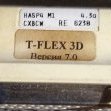Автор:
vin_erra,
25 сентября 2011 в ANSYS CFX
-
Ответить в тему
-
Создать тему
Рекомендованные сообщения
vin_erra
0
-
- Жалоба
- Рассказать
Здравствуйте уважаемые форумчане)
я произвожу расчет в Cfx входного аппарата компрессора. и в Solver он мне выдает ошибку «Floating point exception: Overflow «. сначала он мне выдал это после 6 итерации. тогда я сменила модель турбулентности с к-эпсилон на SST, он посчитал тогда уже 28 итераций и снова выдал мне эту же ошибку.
чем это может быть вызвано и что в этом случае можно предпринять??
- Цитата
Ссылка на сообщение
Поделиться на других сайтах
stydentium
0
-
- Жалоба
- Рассказать
Проверьте масштабы импортируемой в CFX модели… или какая-то из входных/выходных переменных из ГУ задана не в тех единицах…
- Цитата
Ссылка на сообщение
Поделиться на других сайтах
- 1 месяц спустя…
Red Ember
0
-
- Жалоба
- Рассказать
не так давно столкнулся с этим при задании теплового потока. потом глянул (я его через expressions задавал) — ба! ошибся на порядок в формуле для теплоемкости, после чего тепловой поток расходится просто астрономически)))
Проверьте физические величины (например, если задавали материалы и их свойства), поставьте точки для отслеживания величин различных параметров
- Цитата
Ссылка на сообщение
Поделиться на других сайтах
sergeyd
3
-
- Жалоба
- Рассказать
для начала нужно посмотреть сетку. Вероятно, она излишне груба.
sst менее требовательна к ее качеству. и вытерпела дольше.
- Цитата
Ссылка на сообщение
Поделиться на других сайтах
Doomed
0
-
- Жалоба
- Рассказать
Ошибка «Floating point exception: Overflow» обычно означает, что какая то расчетная величина превысила допустимые пределы.
Это бывает если есть плохой элемент в сетке и в этом месте большая погрешность численной схемы, иногда — если задаете стенку с проскальзыванием, если входные/выходные условия заданы неверно(например иногда при задании входных и выходных условий давлением задача расходится или при задании очень больших скоростей), если вводите дополнительные переменные определяя, например, свойства расчетной среды через expressions и там есть ошибка. Может быть в каком то месте расчета возникло деление на ноль.
- Цитата
Ссылка на сообщение
Поделиться на других сайтах
- 2 недели спустя…
vitefimov
0
-
- Жалоба
- Рассказать
попробуйте уменьшить Phisical Timescale в Solver Control
- Цитата
Ссылка на сообщение
Поделиться на других сайтах
Присоединяйтесь к обсуждению
Вы можете опубликовать сообщение сейчас, а зарегистрироваться позже.
Если у вас есть аккаунт, войдите в него для написания от своего имени.
Примечание: вашему сообщению потребуется утверждение модератора, прежде чем оно станет доступным.
-
Сейчас на странице
0 пользователей
Нет пользователей, просматривающих эту страницу.
-
Сообщения
-
-
Автор:
AlexKaz · Опубликовано: 7 часов назад
Обновил и выложил черновик для свободного скачивания. Комментарии и пожелания приветствуются, контакты для связи имеются внутри.
https://www.researchgate.net/publication/371276521_Basics_of_the_control_theory_mechatronics_and_robotics_with_Scilab_Xcos_OpenModelica_wxMaxima_and_GNU_Octave_using_Handbook_in_Russian_draft
-
Автор:
mannul · Опубликовано: 7 часов назад
G05.1 Q1 R1 — грубая высокоскоростная обработка, подача на углах не меняется, углы срезаются, контур не соответствует заданному.
G05.1 Q1 R5 — высокоскоростная обработка, баланс скорость-качество, замедление на углах, углы по прежнему может срезать.
G05.1 Q1 R10 — точная высокоскоростная обработка, значительное замедление на углах, углы не срезаются, контур соответсвует заданному в пределах точности станка.
G05.1 Q0 — выключение.
-
-
Автор:
Артур52 · Опубликовано: 8 часов назад
Там такая обработка, что так будет читабельнее управляющая программа. (В дальнейшем будет УП на станке корректироваться, а не в NX)
-
Автор:
A_1 · Опубликовано: 8 часов назад
Что получится с этой картинкой, если в начале программы для её получения добавить код MIRROR Y0?
Для всех курсов программирования промокод для скидки «ЛЕТО»
Sinumerik: расширенное программирование
Параметрическое программирование станков с ЧПУ FANUC
Программирование станка с системой ЧПУ FANUC (и Sinumerik)
-
-
Автор:
Артур52 · Опубликовано: 9 часов назад
Доброго времени суток, такой вопрос: я хочу часть операций сделать через приращение, а часть в абсолютных координатах, кто знает, где есть это переключение в NX?
-
-
Автор:
куркуль · Опубликовано: 9 часов назад
судя по описанию — сместился шпиндель т.е. ось S. есть два способа — 1 простой — если знаем фактическое положение нуля шпинделя — выставляем в эту позицию — переходим с JOG на JOGREF ( при этом имеем доступ изготовителя, или эксперты ) — нажимаем на +S — при этом движение не происходит, а показания обнуляются. т.е. сменили позицию абсолютного нуля. но не на всех это работает почему-то.
34090 — текущее положение датчика, можно менять, учитывая знаки + и — . изменения вступают только после перезагрузки.
ну и третий — можно сделать привязку на любой позиции, если знаем значение данной позиции.
заходим в MD оси
34200 — ставим 0 даже если стоит ( нажимаем кнопочку — активировать MD данные )
34210 — ставим 1 ( нажимаем кнопочку — активировать MD данные )
нажимаем JOG REF ( должен быть активным )
нажимаем + нашей оси
34210 — должен сам перейти на 2 — ось референцированна.
если не получилась перезагружаем и повторяем.
вчера смена закончилась.
-
11 октября, 2018 — 00:39
#1
Добрый вечер, уважаемые форумчане. В общем, моделирую течение газа в аэродинамической установке — форкамера, сопло, рабочая часть. Все шло вполне себе гладко до сопла, позволяющего получать скорость потока порядка М=6. Подскажите, пожалуйста, о чем может говорить данная ошибка (картинка приложена ниже) и какими способами можно решить проблему. Потому что, ну, не может скорость при прохождении через критическое сечение сопла подниматься до нескольких десятков Махов. Рад любым мыслям, наводкам и подсказкам.
Go to CFD
r/CFD
r/CFD
Members
Online
•
by
PLANTAGENET123
Ansys Fluent: Float point exception error
I had an error of float point exception when doing simulation in Fluent. What does it means and how to avoid this errors.
How to… fix error Floating Point Exception -Overflow in Ansys CFX ?
Many times, during the implementation of numerical modeling, after completing the boundary and initial conditions and starting the solver we have to do with a sudden stop of the analysis and the appearance of an overflow message. This is the most common type of error that occurs when performing CFD analysis. In today’s post, I would like to present two paths to minimize the appearance of this error.
 |
| Most often error in CFX |
The first path will be the method most tested by me from the practical side. It was effective in many cases where I encountered an overflow error. The second path is the standard procedures to follow to get rid of this error. In my opinion, two approaches should be familiarized with to have a full spectrum of knowledge about this error. It’s written in such a general way by the solver, which makes it very difficult to diagnose directly.
To accurately describe and explain the first method, I will use an example of a modeling task. So our problem will be cooling process of the plate at a pressure of 5 bar. For this task, we will adopt the following assumptions: we will take into account the total energy model, we will define compressible air (ideal gas) as gas, we will define the SST turbulence model, we will take into account the radiation phenomenon by adopting the Surface to Surface model and that due to the symmetry of the model we will simplify the geometry to a periodic slice.
After defining the model phenomena, the time step was set at 1 s. Then solver was initiated. After couple of seconds simulation was stopped with an overflow error after seven iterations. What next steps should be taken to locate an analysis failure? Below I will present in order from the least labor-intensive to the most-labor-intensive activity.
1. Reduce the size of the time step. The best reduction ratio is 1:10 scale. So in our case we reduce the step from 1 s to 0.1 s. For transient analyzes, the definition of the correct time step size is much more important than the mesh quality. The residual equations are more responsive to the size of the time step than to the change of the grid size. In the case of static analyzes, we have such factors to change as the pseudo transient step or the time step of the solid domain. If the next reduction to 0.01 s has no effect, proceed to the next step.
2. Change the gas model from compressible to incompressible. This will cause our problem to reduce its nonlinearity. Do not be afraid of this simplification if your problem concerns low pressures and speeds. The differences in gas models in this case should not be large. If this modification also does not help, go to the next one.
3. If the above two points do not work in the next step, turn off the radiation model. This should greatly simplify the analysis and the partial equations will be less susceptible to mesh quality. Radiation models significantly extend the simulation time. A bad mesh may lead to the formation of non-physical temperature values (values greater than the assumed temperature in the boundary and initial conditions).
4) The next stage is to reduce the value of the assumed boundary and initial conditions. If in the analysis you have assumed a pressure of over 2 bar or values close to the phenomenon of vacuum, change this value to atmospheric pressure. Also, when it comes to temperature values (above 1200 C), reduce them by at least half. The same should be done for the initial speed (if you are analyzing high speeds over 150 m / s).
5) If all of the above steps fail, perform the last step. When you have defined symmetry or periodicity, try to do calculations for the entire model without these boundary conditions. It can be quite a laborious step requiring the reconstruction of the model, but it can bring measurable benefits in the implementation of the analysis.
After completing the above steps, if you still have a problem with the error overflow: floating point exception, try the next methods posted on the CFD Online website. Below is a link to these materials. It is worth reading the entire post because the information contained therein is extremely valuable.
Ansys FAQ — CFD-Wiki, the free CFD reference (cfd-online.com)
|
|
|
#1 |
|
Ricky Wong Guest |
Hello, I’m trying to model a plain underexpanded jet (still), and I can’t get the iterations started. Fluent keeps coming back with floating point exception, (underflow). I don’t know what it’s complaining about!. I’ve tried reducing the skewness, checked the grid, re-entered the boundary conditions (trying to start off with a jet at a very low NPR, without turbulence), no joy.. am I grasping at straws or is it something blindingly obvious? please help Thanks |
|
|
|
|
|
|
|
#2 |
|
J. McKelliget Guest |
Your model is diverging. The underexpanded jet is almost impossible to converge using Fluent. Make sure you are using the coupled solver, and maybe some kind of initial guess. |
|
|
|
|
|
|
|
#3 |
|
LW Guest |
Can you explain «Underexpanded Jet»? Thanks! |
|
|
|
|
|
|
|
#4 |
|
J. McKelliget Guest |
Underexpanded jet = a compressible gas flow where the pressure in the jet is substantially higher than the pressure of the region into which it is discharging — leads to lots of shock and expansion waves etc |
|
|
|
|
|
|
|
#5 |
|
John C. Chien Guest |
(1). That’s right. (2). Or, (p,ambient/ p,jet exit) < 1. (3). (p,jet exit) is the nozzle exit pressure but still inside the nozzle. (4). Further expansion will occur in the jet, downstream of the nozzle exit, until the pressure at the boundary of the jet matches the ambient pressure. In between, shocks and expansion waves will form in the jet (or plume). |
|
|
|
|
|
|
|
#6 |
|
Ricky Wong Guest |
Thanks, Managed to get the model started, stripped it down completely to a laminar, incompressible flow at a very low NPR to begin with and gradually increased the NPR as the solution progressed. |
|
|
|
|
|
|
|
#7 |
|
Sung-Eun Kim Guest |
Have you tried to patch a non-zero initial guess for the velocity field ? Please contact your support engineer if the problem doesn’t go away. |
|
|
|
|
|
|
|
#8 |
|
Ricky Wong Guest |
Thanks for the reply Non-zero intial guesses also prompted the error, It wasn’t until I took stripped down the model that it was able to start. Unfortunately I don’t think I have a support engineer, I’m a post-grad and the University has an academic license to which I am not the primary licence holder, queries to fluent (europe) support are very slow in replying (if at all) because an academic license is has low priority. Hence I look to the fluent forum for possible help. |
|
|
|
|
|
|
|
#9 |
|
Member Join Date: Jan 2012 Posts: 58 Rep Power: 13 |
Hello. |
|
|
|
|
|
|
|
#10 |
|
New Member Chng Join Date: Jul 2012 Posts: 6 Rep Power: 12 |
One reason could be that the factors are over-relaxed. So if you are confident that BCs, model and solver are appropriate, try reducing the relaxation factor in solution control. |
|
|
|
|
|
|
|
#11 |
|
Member Omid Shekari Join Date: Jun 2016 Posts: 43 Rep Power: 8 |
Quote:
Originally Posted by Ricky Wong Thanks, Managed to get the model started, stripped it down completely to a laminar, incompressible flow at a very low NPR to begin with and gradually increased the NPR as the solution progressed. What does NOR stand for? |
|
|
|
|
|
|
|
#12 |
|
Member Omid Shekari Join Date: Jun 2016 Posts: 43 Rep Power: 8 |
Quote:
Originally Posted by Ricky Wong Thanks, Managed to get the model started, stripped it down completely to a laminar, incompressible flow at a very low NPR to begin with and gradually increased the NPR as the solution progressed. What does NPR stand for? |
|
|
|
|
|
|
|
#13 |
|
New Member Niaz Join Date: May 2017 Location: islamabad Posts: 11 Rep Power: 8 |
Quote:
Originally Posted by Omish What does NPR stand for? i have the following error in my simulation, kindly if u hav any remedy,post it Divergence detected in AMG solver: pressure correction Error at Node 0: floating point exception Error at Node 1: floating point exception Error at Node 2: floating point exception Error at Node 3: floating point exception Error at Node 4: floating point exception Error at Node 5: floating point exception Error: floating point exception Error Object: #f |
|
|
|
|
|
|
|
#14 |
|
New Member waqas ahmad Join Date: Aug 2018 Posts: 2 Rep Power: 0 |
hI i AM DOING CFD SIMULATION FOR SINGLE CHANNEL PROTON EXCHANGE MEMBRANE FUEL CELL. I AM RECEVING «»»»»» FLOAT POINT EXCEPTION ERROR «»»» DURING CALCULATIONS.. cAN ANYBODY HELP REGARDING THIS?? HOW CAN I FIX THIS? |
|
|
|
|
|
|
|
#15 |
|
New Member waqas ahmad Join Date: Aug 2018 Posts: 2 Rep Power: 0 |
I m also receving the same error……. |
|
|
|
|
|
|
|
#16 |
|
New Member Yury Voloshchuk Join Date: Aug 2017 Posts: 2 Rep Power: 0 |
you may change your AMG solver settings: go to Solution Controls —> Advanced You may add Pre-Sweeps in both scalar and coupled parameters. Apart from that, you may change Cycle type for Flow, TKE, SDR, Enregy, and Radiation model to either V- or W-Cycle. Also you could add BCGSTAB Stabilization Method. I advise you to use earlier Fluent version, such as 14.5, and do set ups and calculations there. Be sure that you use the same fluent version all the time! P.S.: if this doesn’t work, try to do hybrid initialization without patching, and run couple of iterations with low URFs. Hope it helped. |
|
|
|
|
|
|
|
#17 |
|
New Member Kaixin Wang Join Date: Sep 2018 Posts: 2 Rep Power: 0 |
hello |
|
|
|
|
|
|
|
#18 |
|
New Member Tatiana Flechas Join Date: Sep 2017 Posts: 10 Rep Power: 7 |
Hello, Has anybody come across the reason and the possible alternatives to solve this issue? Any help will be greatly appreciated! |
|
|
|
|
|
|
|
#19 |
|
New Member Basil Varghese Join Date: Feb 2020 Posts: 3 Rep Power: 5 |
I have been doing simulation on natural convection in heat sink in transient state. |
|
|
|
|
|
|
|
#20 |
|
Senior Member
Vinerm Join Date: Jun 2009 Location: Nederland Posts: 2,946 Blog Entries: 1 Rep Power: 34 |
The value of the time-step is critical in most of the transient simulations and need to be chosen properly. 5 s is a very very large value for time-step. Depending upon Gr number, it could be anything from around 0.1 s to all the way down to 1e-6 or even 1e-7 s. But 5 s is not possible. So, use such a time-step so that solution within every time-step converges in less than or equal to 30 iterations.
__________________ PM to be used if and only if you do not want something to be shared publicly. PM is considered to be of the least priority. |
|
|
|
|










